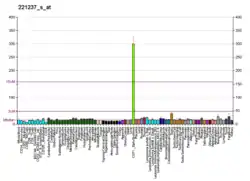OSBP2
Oxysterol-binding protein 2 is a protein that in humans is encoded by the OSBP2 gene.[5][6][7][8]
| OSBP2 | |||||||||||||||||||||||||||||||||||||||||||||||||||
|---|---|---|---|---|---|---|---|---|---|---|---|---|---|---|---|---|---|---|---|---|---|---|---|---|---|---|---|---|---|---|---|---|---|---|---|---|---|---|---|---|---|---|---|---|---|---|---|---|---|---|---|
| Identifiers | |||||||||||||||||||||||||||||||||||||||||||||||||||
| Aliases | OSBP2, HLM, ORP-4, ORP4, OSBPL1, OSBPL4, oxysterol binding protein 2 | ||||||||||||||||||||||||||||||||||||||||||||||||||
| External IDs | OMIM: 606729 MGI: 1921559 HomoloGene: 75303 GeneCards: OSBP2 | ||||||||||||||||||||||||||||||||||||||||||||||||||
| |||||||||||||||||||||||||||||||||||||||||||||||||||
| |||||||||||||||||||||||||||||||||||||||||||||||||||
| |||||||||||||||||||||||||||||||||||||||||||||||||||
| |||||||||||||||||||||||||||||||||||||||||||||||||||
| |||||||||||||||||||||||||||||||||||||||||||||||||||
| Wikidata | |||||||||||||||||||||||||||||||||||||||||||||||||||
| |||||||||||||||||||||||||||||||||||||||||||||||||||
Oxysterols are byproducts of cholesterol that can have cytotoxic effects on many cell types. The protein encoded by this gene contains a pleckstrin homology (PH) domain and an oxysterol-binding region. It binds oxysterols such as 7-ketocholesterol and may inhibit their cytotoxicity. Alternate transcriptional splice variants have been observed but have not been fully characterized.[8]
References
- GRCh38: Ensembl release 89: ENSG00000184792 - Ensembl, May 2017
- GRCm38: Ensembl release 89: ENSMUSG00000020435 - Ensembl, May 2017
- "Human PubMed Reference:". National Center for Biotechnology Information, U.S. National Library of Medicine.
- "Mouse PubMed Reference:". National Center for Biotechnology Information, U.S. National Library of Medicine.
- Dunham I, Shimizu N, Roe BA, Chissoe S, Hunt AR, Collins JE, Bruskiewich R, Beare DM, Clamp M, Smink LJ, Ainscough R, Almeida JP, Babbage A, Bagguley C, Bailey J, Barlow K, Bates KN, Beasley O, Bird CP, Blakey S, Bridgeman AM, Buck D, Burgess J, Burrill WD, O'Brien KP, et al. (Dec 1999). "The DNA sequence of human chromosome 22". Nature. 402 (6761): 489–95. Bibcode:1999Natur.402..489D. doi:10.1038/990031. PMID 10591208.
- Moreira EF, Jaworski C, Li A, Rodriguez IR (May 2001). "Molecular and biochemical characterization of a novel oxysterol-binding protein (OSBP2) highly expressed in retina". J Biol Chem. 276 (21): 18570–8. doi:10.1074/jbc.M011259200. PMID 11278871.
- Wang C, JeBailey L, Ridgway ND (Jan 2002). "Oxysterol-binding-protein (OSBP)-related protein 4 binds 25-hydroxycholesterol and interacts with vimentin intermediate filaments". Biochem J. 361 (Pt 3): 461–72. doi:10.1042/0264-6021:3610461. PMC 1222328. PMID 11802775.
- "Entrez Gene: OSBP2 oxysterol binding protein 2".
Further reading
- Hirosawa M, Nagase T, Murahashi Y, et al. (2001). "Identification of novel transcribed sequences on human chromosome 22 by expressed sequence tag mapping". DNA Res. 8 (1): 1–9. doi:10.1093/dnares/8.1.1. PMID 11258795.
- Lehto M, Laitinen S, Chinetti G, et al. (2001). "The OSBP-related protein family in humans". J. Lipid Res. 42 (8): 1203–13. doi:10.1016/S0022-2275(20)31570-4. PMID 11483621.
- Jaworski CJ, Moreira E, Li A, et al. (2002). "A family of 12 human genes containing oxysterol-binding domains". Genomics. 78 (3): 185–96. doi:10.1006/geno.2001.6663. PMID 11735225.
- Strausberg RL, Feingold EA, Grouse LH, et al. (2003). "Generation and initial analysis of more than 15,000 full-length human and mouse cDNA sequences". Proc. Natl. Acad. Sci. U.S.A. 99 (26): 16899–903. Bibcode:2002PNAS...9916899M. doi:10.1073/pnas.242603899. PMC 139241. PMID 12477932.
- Henriques Silva N, Vasconcellos Fournier M, Pimenta G, et al. (2004). "HLM/OSBP2 is expressed in chronic myeloid leukemia". Int. J. Mol. Med. 12 (4): 663–6. doi:10.3892/ijmm.12.4.663. PMID 12964051.
- Ota T, Suzuki Y, Nishikawa T, et al. (2004). "Complete sequencing and characterization of 21,243 full-length human cDNAs". Nat. Genet. 36 (1): 40–5. doi:10.1038/ng1285. PMID 14702039.
- Wyles JP, Perry RJ, Ridgway ND (2007). "Characterization of the sterol-binding domain of oxysterol-binding protein (OSBP)-related protein 4 reveals a novel role in vimentin organization". Exp. Cell Res. 313 (7): 1426–37. doi:10.1016/j.yexcr.2007.01.018. PMID 17350617.
This article is issued from Wikipedia. The text is licensed under Creative Commons - Attribution - Sharealike. Additional terms may apply for the media files.




